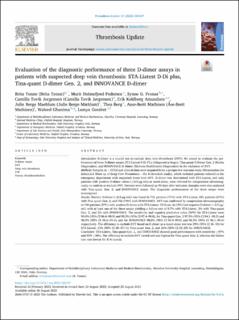| dc.contributor.author | Tønne, Brita | |
| dc.contributor.author | Pedersen, Marit Holmefjord | |
| dc.contributor.author | Frønæs, Synne Grønvold | |
| dc.contributor.author | Jørgensen, Camilla Tøvik | |
| dc.contributor.author | Amundsen, Erik Koldberg | |
| dc.contributor.author | Mæhlum, Julie Berge | |
| dc.contributor.author | Berg, Thea | |
| dc.contributor.author | Mathisen, Åse-Berit | |
| dc.contributor.author | Ghanima, Waleed | |
| dc.contributor.author | Garabet, Lamya Samir Noori | |
| dc.date.accessioned | 2024-02-21T06:59:24Z | |
| dc.date.available | 2024-02-21T06:59:24Z | |
| dc.date.created | 2023-10-06T10:52:10Z | |
| dc.date.issued | 2023 | |
| dc.identifier.citation | Thrombosis Update. 2023, 13 . | en_US |
| dc.identifier.uri | https://hdl.handle.net/11250/3118813 | |
| dc.description.abstract | Introduction: D-dimer is a crucial test to exclude deep vein thrombosis (DVT). We aimed to evaluate the per- formance of three D-dimer assays: STA-Liatest D-Di Plus (Diagnostica Stago), Tina-quant D-Dimer Gen. 2 (Roche Diagnostics), and INNOVANCE D-Dimer (Siemens Healthineers Diagnostics) in the exclusion of DVT.
Methods: Samples (n = 1032) and clinical data were acquired from a prospective outcome study (Rivaroxaban for Scheduled Work-up of Deep Vein Thrombosis – the Ri-Schedule study), which included patients referred to the emergency department with suspected lower-limb DVT. D-dimer was determined with STA-Liatest, and only patients with positive D-dimer values (≥0.5 μg/mL) as stand-alone, were referred for compression ultrasonog- raphy to confirm or exclude DVT. Patients were followed up 90 days after inclusion. Samples were also analyzed with Tina-quant Gen. 2, and INNOVANCE assays. The diagnostic performances of the three assays were investigated.
Results: Positive D-dimer (≥0.5 μg/mL) was found in 733 patients (71%) with STA-Liatest, 691 patients (67%) with Tina-quant Gen. 2, and 766 (74%) with INNOVANCE. DVT was confirmed by compression ultrasonography in 196 patients (27%) with positive D-dimer with STA-Liatest. Of those, six (3%) had negative D-dimer (<0.5 μg/ mL) with at least one of the three assays yielding a failure rate of 0.7% with STA-Liatest, 2% with Tina-quant Gen. 2, and 2% with INNOVANCE. The sensitivity and negative predictive value (NPV) for STA-Liatest were 99.0% (95% CI 96.4–99.9) and 99.3% (95% CI 97.4–99.8), for Tina-quant Gen. 2 97.5% (95% CI 94.1–99.2) and 98.5% (95% CI 96.6–99.4), and for INNOVANCE 98.0% (95% CI 94.9–99.0) and 98.5% (95% CI 96.1–99.4) respectively. The efficiency to exclude DVT based on D-dimer as a stand-alone test was 29% (95% CI 26–33) for STA-Liatest, 33% (95% CI 30–37) for Tina-quant Gen. 2, and 26% (95% CI 23–29) for INNOVANCE. Conclusion: STA-Liatest, Tina-quant Gen. 2, and INNOVANCE showed good performances with sensitivity ≥97% and NPV ≥98%. The efficiency to exclude DVT varied and was highest for Tina-quant Gen. 2, whereas the failure rate was lowest for STA-Liatest. | en_US |
| dc.language.iso | eng | en_US |
| dc.rights | Navngivelse 4.0 Internasjonal | * |
| dc.rights.uri | http://creativecommons.org/licenses/by/4.0/deed.no | * |
| dc.title | Evaluation of the diagnostic performance of three D-dimer assays in patients with suspected deep vein thrombosis: STA-Liatest D-Di plus, Tina-quant D-dimer Gen. 2, and INNOVANCE D-dimer | en_US |
| dc.type | Journal article | en_US |
| dc.type | Peer reviewed | en_US |
| dc.description.version | publishedVersion | en_US |
| cristin.ispublished | true | |
| cristin.fulltext | original | |
| cristin.qualitycode | 1 | |
| dc.identifier.doi | 10.1016/j.tru.2023.100147 | |
| dc.identifier.cristin | 2182375 | |
| dc.source.journal | Thrombosis Update | en_US |
| dc.source.volume | 13 | en_US |
| dc.source.pagenumber | 5 | en_US |

